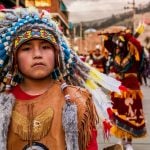Native American Heritage Day
 Chief Pretty Nose, Cheyenne, 1878. https://imgur.com/gallery/CFggo
Chief Pretty Nose, Cheyenne, 1878. https://imgur.com/gallery/CFggo
Yesterday, November 24, 2017, the day after Thanksgiving, was celebrated as Native American Heritage Day. The month of November is generally designated as Native American Heritage Month.
According to www.census.gov/…, the first American Indian Day was celebrated in May 1916 in New York. Red Fox James, a member of the Blackfeet Nation, rode horseback from state to state to get endorsements from 24 state governments to have a day to honor American Indians.
In 1990, President George H.W. Bush signed a joint congressional resolution designating November 1990 as “National American Indian Heritage Month.” Similar proclamations have been issued every year since 1994, and we now refer to this celebration as “American Indian and Alaska Native Heritage Month.”
Here are a few noteworthy tweets from around the nation, celebrating the heritage, culture and struggle of our brothers and sisters.
#NativeAmericanHeritageDay is a day to celebrate and recognize the contributions, culture, tradition and heritage of Native American’s. Take time today to discover more… https://t.co/tC1pPT2WYq pic.twitter.com/sz9eHeYbie
’ NationalDayCalendar (@NationalDayCal) November 24, 2017
On #NativeAmericanHeritageDay just take a few minutes to appreciate the beauty and diversity of people who called this land their home. pic.twitter.com/kQ2zN2JNvE
’ Red T Raccoon (@RedTRaccoon) November 24, 2017
For Native American Heritage Day – share how researchers @UCBerkeley are saving early 20th century native american audio recordings: https://t.co/g5ykJGurSR #NativeAmericanHeritageDay pic.twitter.com/vllBoofktn
’ National Science Fdn (@NSF) November 24, 2017
In honor of #NativeAmericanHeritageDay today: The extraordinary photographs of Edward S. Curtis are incredibly important documentation of Native American culture and tradition. Mr. Curtis began his defining life’s work in 1895 & advocated for Native American communities… pic.twitter.com/VAP5exPg9S
’ Trevor (@TRSDC) November 24, 2017
Follow the link in the tweet below for a superb collection of early twentieth century photographs by Edward Sheriff Curtis.
Also mashable.com/… for some portraits.
An expansive photo record of Native American life in the early 1900s https://t.co/P11GRWDbWy #NativeAmerican #NativeAmericanHeritageDay
’ WebVixen (@webvixen) November 28, 2015
November 24 #NativeAmericanHeritageDay #ChiefJoseph pic.twitter.com/k904dD7Hzu
’ John Fusco (@JohnFusco12) November 22, 2017
They were on to something here. #NativeAmericanHeritageDay pic.twitter.com/lAqn8dUnyM
’ Daniel ’This Is All Really Happening’ Meersand (@DanMeersand) November 24, 2017
For #NativeAmericanHeritageDay – 10 books by indigenous authors you should read. https://t.co/RYqUEnaZwo
’ Jonathan Shipley (@shipleywriter) November 24, 2017
Some Native American film footage –
In June 2014, President Barack Obama and the First Lady made an historic visit to the Standing Rock Sioux Indian Reservation in North Dakota. He was only the fourth sitting President to visit Indian Country, joining Coolidge in 1927, Roosevelt in 1936, and Clinton in 1999.
 nativenewsonline.net/…
nativenewsonline.net/…
#NativeAmericanHeritageDay Short film on #NoDAPL standoff https://t.co/O7xVEkcIHX via @motherjones @WinonaLaduke @HonorTheEarth
’ The Seventh Fire (@TheSeventhFire) November 25, 2016
ARAWAK PRIDE! #NativeAmericanHeritageDay pic.twitter.com/Un6qUDzhfJ
’ An Musing Woman (@MuseyMo) November 24, 2017
Native American chef Sean Sherman, owner of the company Sioux Chef, dedicates his time to revitalizing Native American cuisine.
Simon Moya-Smith argues below that we should move Native American Heritage Day to a new date, away from Black Friday, which is the antithesis of Native American morals.
#NativeAmericanHeritageDay : Time to rethink by Simon Moya-Smith https://t.co/xfOfGaSrs4
’ Arapaho Nation (@ArapahoNation) November 30, 2015
Note that the day after Thanksgiving is now also celebrated as “Black Hole Friday” — a day to learn about cosmology and black holes. See diary at www.dailykos.com/… for some details. NASA decided to take Black Friday head on and divert people’s attention away from mindless shopping to education and learning.
Other Resources
The tweets above refer to several sites and books that can help fill the gaps in the understanding of our fellow travelers in this journey of life. The wiki page on Native Americans is a good place to start en.wikipedia.org/…
Also see several excellent diaries by Ojibwa and Native American Netroots.
See www.census.gov/… for information about population and demographic data about native Americans. The nation’s American Indian and Alaska Native population numbers 6.7 million, including those of more than one race. They made up about 2.0 percent of the total population in 2016. There are over 500 federally recognized tribes within the U.S.
Howard Zinn, in “A People’s History of the United States” provides some vivid insights of a people and culture now mostly lost upon the average modern mind — www.historyisaweapon.com/… —
So, Columbus and his successors were not coming into an empty wilderness, but into a world which in some places was as densely populated as Europe itself, where the culture was complex, where human relations were more egalitarian than in Europe, and where the relations among men, women, children, and nature were more beautifully worked out than perhaps any place in the world.
They were people without a written language, but with their own laws, their poetry, their history kept in memory and passed on, in an oral vocabulary more complex than Europe’s, accompanied by song, dance, and ceremonial drama. They paid careful attention to the development of personality, intensity of will, independence and flexibility, passion and potency, to their partnership with one another and with nature.
John Collier, an American scholar who lived among Indians in the 1920s and 1930s in the American Southwest, said of their spirit: “Could we make it our own, there would be an eternally inexhaustible earth and a forever lasting peace.”
Perhaps there is some romantic mythology in that. But the evidence from European travelers in the sixteenth, seventeenth, and eighteenth centuries, put together recently by an American specialist on Indian life, William Brandon, is overwhelmingly supportive of much of that “myth.” Even allowing for the imperfection of myths, it is enough to make us question, for that time and ours, the excuse of progress in the annihilation of races, and the telling of history from the standpoint of the conquerors and leaders of Western civilization.
There are people here at DK who are much better qualified than me to write about Native Americans, their history, culture and struggles past and present. Hopefully, some on of them will provide their insights in diaries and in comments below. I hope I did not include any inaccurate, misrepresented or controversial info in this diary.



